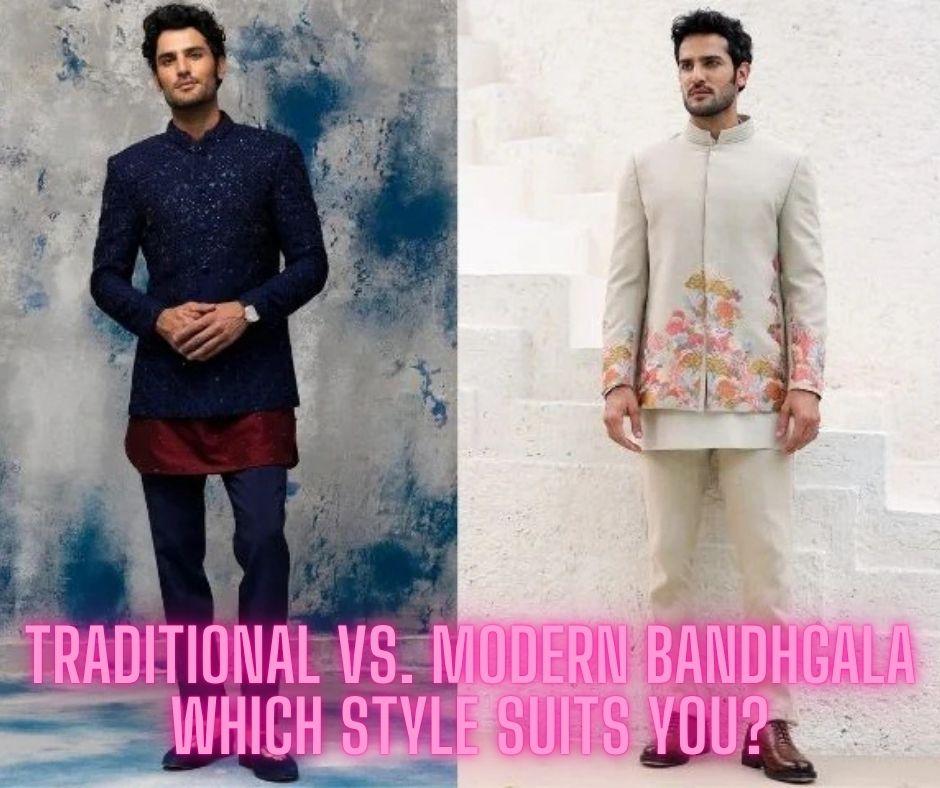Thinking of upping your style game for a wedding or a formal occasion? Enter the Bandhgala—India’s answer to the tuxedo, and then some. It’s sharp, regal, and versatile. But when faced with the choice between a traditional Bandhgala and a modern version, it’s easy to feel stuck. Let’s break it all down so you can find the perfect fit for your personality and the occasion.
For a wide range of both classic and contemporary Bandhgalas, check out the Best menswear shop in Jaipur—where heritage meets modern craftsmanship.
What is a Bandhgala?
The Roots of Bandhgala
The Bandhgala, also known as the Jodhpuri suit, traces its royal lineage back to Rajasthan. It emerged during the British Raj, combining British tailoring with Indian elegance. The name Bandhgala literally means “closed neck,” and that high-collar feature is what makes it stand out.
The Essence of Royalty
Originally worn by kings and aristocrats, the Bandhgala is synonymous with luxury, tradition, and power. It has evolved over the years, but its heart still beats in the rhythm of Indian royalty.
Traditional Bandhgala: A Glimpse into the Past
Fabrics and Embroidery
Traditional Bandhgalas are crafted from rich fabrics like silk, brocade, and velvet. They often feature intricate hand embroidery—think zardozi, resham, or even kundan work. These details aren’t just decorative; they tell stories of India’s artistic legacy.
Style and Cut
The cut is usually structured, fitting snug at the chest and waist. Traditional Bandhgalas come with matching churidars or breeches and are meant to create a regal silhouette. The buttons? Often ornate and sometimes even jeweled.
When and Where to Wear It
Weddings, festive occasions, and cultural events are perfect for a traditional Bandhgala. If you want to make an impression at a Diwali party or your cousin’s big fat Indian wedding—this is your go-to.
Modern Bandhgala: A Contemporary Take
Fusion of Styles
Today’s designers are putting a fresh spin on the classic. The modern Bandhgala might come with asymmetrical cuts, contrasting lapels, or even paired with trousers instead of churidars. It’s where Indian tradition meets Western flair.
Minimalist Designs and Modern Fabrics
Say goodbye to heavy embroidery and hello to clean lines, subtle patterns, and lightweight materials like linen, cotton blends, or suiting wool. These Bandhgalas are made for movement—and for air-conditioned cocktail parties.
Perfect for Modern Occasions
Whether it's a corporate event, a destination wedding, or a gala dinner, the modern Bandhgala is built for versatility. It doesn’t scream tradition, but it whispers elegance.
Key Differences Between Traditional and Modern Bandhgala
Design and Aesthetic
Traditional Bandhgalas are about grandeur—heavy embroidery, royal colors like maroon, navy, or gold. Modern ones lean towards neutral shades, subtle textures, and sharp tailoring.
Functionality and Comfort
Old-school styles may look stunning, but they can feel heavy and hot. Modern versions prioritize breathability and comfort, making them more wearable in different climates.
Occasions and Versatility
While traditional styles are event-specific, modern Bandhgalas can double up for formal and semi-formal events. You can even style them down with jeans—yes, that’s a thing now.
Which Bandhgala Style Suits You?
Understanding Your Personality and Style
Are you a traditionalist at heart or a trendsetter? If you love heritage, the classic Bandhgala might be your soulmate. But if you enjoy experimenting with your look, the modern Bandhgala is calling your name.
Body Type Considerations
A structured traditional Bandhgala looks great on taller or broader frames. Meanwhile, the sleeker, modern cut is more forgiving and flatters a variety of body types.
Occasion and Purpose
For a family wedding or religious celebration, go traditional. For office parties, formal dinners, or even a red-carpet moment—modern all the way.
Styling Tips for Both Traditional and Modern Bandhgalas
Footwear and Accessories
-
Traditional: Pair with juttis or mojris, and go bold with a brooch or pocket square.
-
Modern: Loafers or leather shoes work best. A minimalist lapel pin or a smartwatch can add a trendy edge.
Color Combinations and Seasonal Styling
In winters, darker shades and velvet work wonders. For summer, choose lighter colors in linen or cotton. Think navy blue for an all-weather style or ivory for daytime elegance.
Why Every Man Needs a Bandhgala in His Wardrobe
The Bandhgala is more than just a jacket. It's a statement. Whether you're stepping into a cultural event or making a fashion-forward choice at a modern affair, it’s your secret weapon to looking timeless. One Bandhgala—traditional or modern—can completely transform your look.
Conclusion
So, which Bandhgala suits you best? If you value tradition, history, and rich craftsmanship, the classic version will never disappoint. But if you're all about comfort, versatility, and contemporary style, a modern Bandhgala will keep you ahead of the curve. The best part? You don't really have to choose—own both and dress like royalty whenever the occasion calls.
FAQs
1. Can I wear a Bandhgala to a business event?
Yes, especially a modern Bandhgala. Opt for subtle colors and lightweight fabrics for a sleek, professional appearance.
2. Are Bandhgalas only for weddings?
Not at all. While traditional ones are great for weddings, modern Bandhgalas work perfectly for formal dinners, galas, or even festive office events.
3. What pants go well with a Bandhgala?
Traditional Bandhgalas pair best with churidars or breeches. Modern ones look fantastic with tailored trousers or even slim-fit jeans for a casual vibe.
4. How should I accessorize a Bandhgala?
Minimalist brooches, pocket squares, and traditional footwear like juttis or formal shoes can elevate your look. Keep it balanced and elegant.
5. What color Bandhgala should I choose?
For versatility, navy, black, or ivory are great picks. If you want something more festive, maroon, royal blue, or emerald green are stunning choices.




